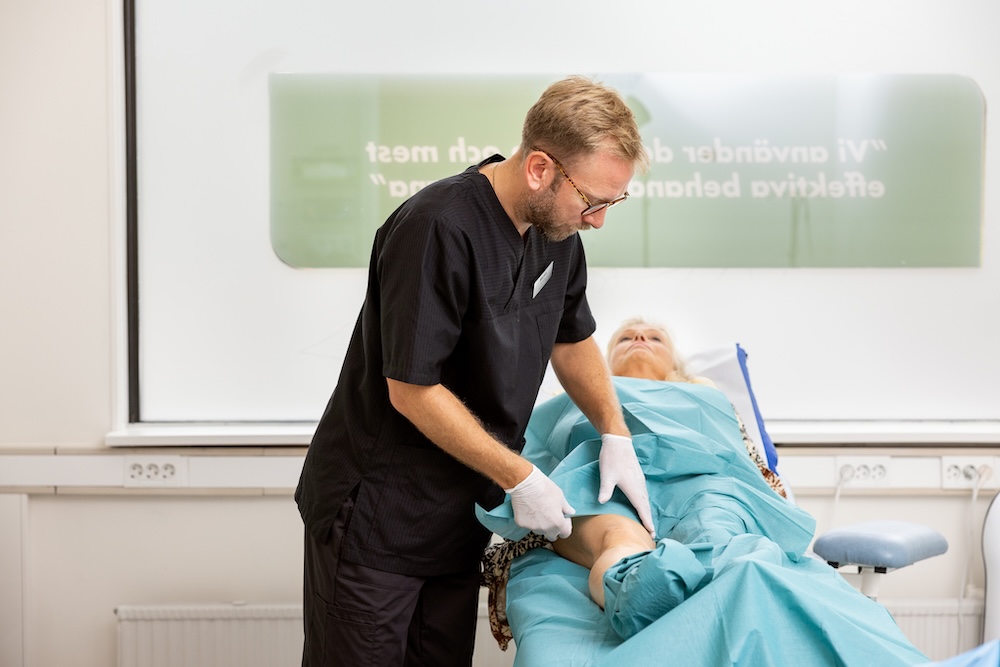



A leg ulcer is an open, non-healing wound on the lower leg, usually caused by chronic vein problems like varicose veins. These ulcers can become painful, infected, and long-lasting. At UK Vein Care, we don’t treat leg ulcers directly — but we do treat one of the most common root causes: varicose veins and venous insufficiency.
A venous leg ulcer forms when blood doesn’t flow properly back to the heart, typically because of faulty valves in the leg veins. This poor circulation increases pressure, damages the surrounding tissue, and eventually causes the skin to break down.
Over time, even a minor injury or skin irritation can turn into a slow-healing ulcer. As explained in our article on why leg ulcers happen, this condition is often connected to untreated varicose veins.
Many people confuse leg ulcers with milder conditions like varicose or spider veins. While related, these are very different in terms of severity and symptoms. The table below shows how they compare:
Leg ulcers often begin with skin changes — such as darkening or dryness — followed by itching, swelling or eczema. When the skin breaks, the wound may weep fluid and resist healing. Pain tends to increase when standing or walking.
These symptoms are often preceded by vein-related issues. See our article on early stage varicose vein symptoms to understand what may come before an ulcer forms.
Venous leg ulcers tend to affect older adults, especially those with a history of varicose veins, blood clots or prolonged standing. Pregnancy and family history can also increase risk.
Our article on venous insufficiency explains why poor vein function is often the real issue behind ulcer development.
We do not treat the ulcer itself — but we help prevent recurrence by treating the underlying varicose veins. Left unaddressed, vein disease will continue to damage the tissue and lead to new or worsening ulcers.
Using duplex ultrasound, our specialists assess your vein function and offer modern, minimally invasive treatments such as laser therapy or foam sclerotherapy. For more information, see our overview of varicose vein treatment options.
Many people think of leg ulcers as surface-level skin problems, but in reality, they are often the result of deeper issues within the veins. When the valves in the leg veins no longer function properly, blood begins to pool in the lower leg instead of flowing back toward the heart. This backward flow creates high pressure inside the veins, a condition known as venous hypertension.
Venous hypertension gradually damages the small blood vessels that supply the skin. Oxygen delivery is reduced, inflammation increases, and the skin becomes more fragile. As a result, even a small injury or irritation can lead to a wound that struggles to heal. Over time, the skin may break down entirely and form a chronic ulcer.
This is why it is important to look beyond the skin and examine the condition of the veins underneath. At UK Vein Care, we focus on identifying problems like venous reflux and offering targeted treatment options. While we do not treat ulcers directly, improving vein function helps reduce the pressure that caused the ulcer in the first place and supports healthier skin overall.
One of the most difficult things about venous leg ulcers is that they rarely heal without addressing the cause. Bandages and creams may help temporarily, but unless the vein pressure is relieved, the wound usually returns.
Leg ulcers are not just a skin problem — they are a sign of poor circulation. We explain the role of veins in our article on why leg ulcers happen, and why treating varicose veins early can stop the cycle of breakdown and regrowth.
At UK Vein Care, our focus is long-term prevention. By restoring healthy vein flow, we help reduce the risk of future ulcers, even if you’re receiving ulcer care elsewhere.
This article is based on research and publications from reputable sources to provide you with the most reliable information. Here are some of the main sources used:
Journal of Vascular Surgery – O’Donnell et al. – Management of Venous Leg Ulcers
https://www.jvascsurg.org/article/S0741-5214(14)00851-9/fulltextBy using these sources, you can be sure that the article is based on current and scientifically reviewed information.

Become varicose vein free: We offer full treatment at a fixed and transparent price regardless of the treatment method. With us, there are no hidden fees.
Learn more about our prices

